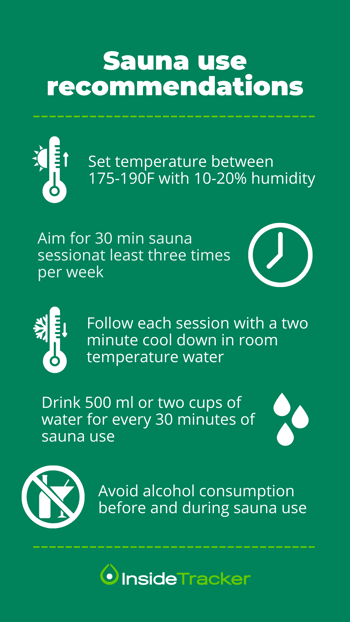![]() Sauna bathing has been used for centuries as a means of relaxation, but it’s becoming increasingly popular in the modern age among biohackers, athletes, and everyday men and women. Evidence suggests that the effects of sauna bathing go beyond relaxation, and instead may also improve cardiovascular function, reduce inflammation, and lower cholesterol. But how often do you need to use a sauna to reap these benefits? What temperature is considered optimal? Is sauna bathing safe for everyone? We’ll answer these questions and more in our latest article.
Sauna bathing has been used for centuries as a means of relaxation, but it’s becoming increasingly popular in the modern age among biohackers, athletes, and everyday men and women. Evidence suggests that the effects of sauna bathing go beyond relaxation, and instead may also improve cardiovascular function, reduce inflammation, and lower cholesterol. But how often do you need to use a sauna to reap these benefits? What temperature is considered optimal? Is sauna bathing safe for everyone? We’ll answer these questions and more in our latest article.
 What is sauna bathing?
What is sauna bathing?
Sauna bathing is a form of heat therapy that exposes you to a high temperature for a short period of time.
There are several types of saunas, all of which revolve around one similar feature—increased temperature. One of the most popular sauna types is the dry heat Finnish sauna, commonly found in many health clubs and spas. Steams rooms or Turkish-style Hannaman are another variety of saunas that generate humid heat through steam. Infrared saunas, which have recently gained popularity, use infrared light to generate dry heat. Infrared light produces many of the same benefits as traditional saunas but at lower and more tolerable temperatures.
Is sauna bathing healthy?
When exposed to high temperatures, the body endures a bit of (healthy) stress as it works to cool down. These effects are similar to those from aerobic exercise—heart rate, blood flow, and cardio output all increase while blood pressure decreases. As body temperature rises, the heart works harder to bring more blood to the surface of the skin to increase sweat output and bring body temperature down. This concept causes the body to increase oxygen use, just as is the case during exercise.[1] Similar to exercise, sauna use can have significant cardiovascular and longevity benefits.
What does the research say about sauna, heart health, and longevity?
Multiple studies show a link between sauna bathing and a reduced risk of heart disease. A 2015 study published in JAMA found that long-term, frequent sauna use (over 20 years, four to seven times a week) was associated with a reduced risk of several heart issues, including sudden cardiac death, fatal coronary heart disease, fatal cardiovascular disease, and all-cause mortality.[2] What’s more, recent research has found that long-term sauna use is also associated with a significantly reduced risk of stroke.[3] And those who engage in consistent exercise may experience even more health benefits from using a sauna. One observational study found that a combination of frequent aerobic exercise plus sauna bathing was associated with a reduced risk of fatal cardiovascular and all-cause mortality.
What about markers of cholesterol? When looking at cholesterol specifically, one study found that just two short weeks of sauna use improved both total and LDL (bad) cholesterol in females. Another study showed similar results—after completing just 10 sauna sessions, participants saw both their LDL and total cholesterol decline. However, it’s important to note that the levels did return to baseline a few weeks after the experiment ended.[4] Frequent sauna use could result in longer-lasting changes.
Sauna use may also improve inflammation and immunity
Regular sauna use may also help reduce inflammation, according to research. A study found that those who engaged in regular sauna use had lower levels of the inflammatory marker CRP. This held true even after the authors adjusted for several variables including age, BMI, alcohol use, and physical activity.[5] Another study showed similar results—a reduction in a similar inflammatory marker, hsCRP, was associated with frequent sauna use. Interestingly, frequent sauna users also had lower levels of white blood cells (WBC), specifically leukocytes. Since WBCs are part of our body's inflammatory response, these findings may be related to improvements in our inflammatory pathway.
 Ready to use a sauna? Here’s how to optimize sauna use
Ready to use a sauna? Here’s how to optimize sauna use
To reap the health benefits of sauna use, InsideTracker recommends choosing a temperature between 175-195F (80-90C) with 10-20% humidity for 30-minute sauna sessions at least three times per week. For the best results, follow each session with a 2-minute cool-down in room temperature water. If 30 minutes is too long, you can break this down into shorter sessions followed by cool-downs in room temperature water in between. Other forms of sauna, like infrared sauna and steam saunas, may also be beneficial.
Before you start sauna bathing, here are some things to consider
Stay hydrated! To avoid side effects like dizziness or headaches, you must properly hydrate. Either bring water into the sauna with you or rehydrate after your session. Aim for a minimum of 500 ml (~2 cups of water) for every 30 mins of sauna use. Check out this blog for more information on how to stay hydrated. Also, it’s best to refrain from saunas if you are pregnant, have unstable cardiovascular disease, high blood pressure, or struggle with claustrophobia. And lastly, avoid alcohol before or during sauna use.
A recap of sauna bathing's impacts on heart health and longevity
- Sauna bathing is a form of heat therapy that exposes you to high temperatures for a short period of time.
- Frequent sauna bathing improves cardiovascular function, reduces inflammation, and may improve lipid profile.
- For optimal results, choose a temperature between 175-195F (80-90C) with 10-20% humidity for 30-minutes at least three times a week.
- Remember to stay hydrated during sauna use, avoid alcohol, and refrain from using a sauna if you are pregnant or have heart issues.
![]()
Diana Licalzi, MS, RD
Diana is a Content Strategist and Team Nutritionist at InsideTracker. As a Registered Dietitian and self-proclaimed "biohacker," Diana enjoys researching and testing the latest trends and technology in the field of nutrition and aging. You'll often find Diana, completing a 24-hour fast, conducting self-experiments, or uncovering strategies to increase longevity. Follow her on Instagram at @dietitian.diana.
References
[1] https://pubmed.ncbi.nlm.nih.gov/2759081/
[2] https://pubmed.ncbi.nlm.nih.gov/25705824/
[3] https://pubmed.ncbi.nlm.nih.gov/29720543/
